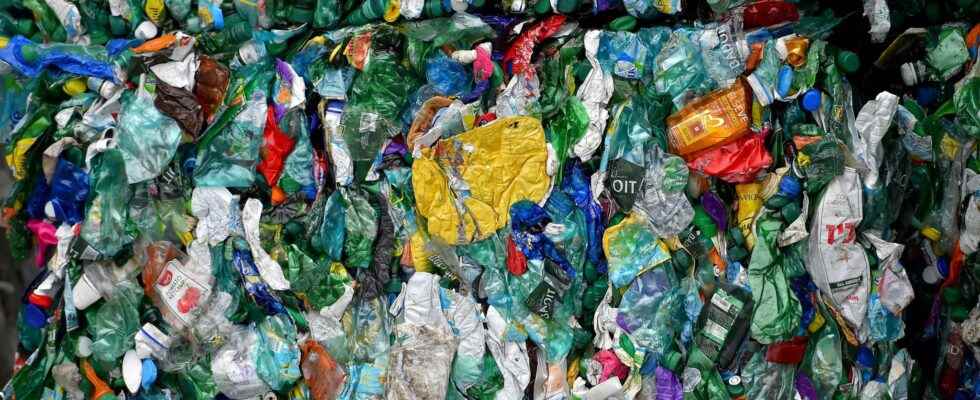The leap is spectacular. In less than ten years, Lithuania has taken a giant leap in the management of its plastic packaging waste: its recycling rate has increased from 38.9% (in 2011) to 69.6% (in 2019), according to Eurostat. Admittedly, the figures have been revised slightly downwards according to the latest data published by the European institution, with 56.1% in 2020, and certain disparities in the rates between States are partly attributable to methodologies that may differ from one country to another. country to country – what the Commission wants to harmonize. Nevertheless: compared to Lithuania, France and its 21.4% pale in comparison. Well below the average of the Twenty-Seven, estimated at 37.7% by Eurostat.
How did this Baltic country of 2.8 million inhabitants become so successful in the field of plastic packaging recycling? Its success is largely based… on a simple deposit program, introduced in 2016 by the government. Nothing revolutionary, then. Customers buy certain products, especially drinks, by paying an additional ten cents – the price of the deposit. This sum is paid back to them when they return the bottles (plastic, glass) or cans, containers ranging from 0.1 to 3 litres, to automatic or manual collection points. These are located near supermarkets of more than 300 m2 in cities and stores of 60 m2 in rural areas. The waste is sent to recycling centers by Usad (Užstato Sistemos Administratorius), the national system operator. This private non-profit company, created from scratch for this project, is made up of three entities: the association of brewers, the federation of companies (the equivalent of the French Medef) and the association of mineral water manufacturers. .
2029 targets achieved in 2017
“At the end of the first year, the collection rate of plastic bottles for recycling had reached 75%. By 2021, this rate was around 90% for plastic bottles and cans, 85% for glass” , reports Stéphan Arino, Director of Public Affairs Western Europe at Tomra. The Norwegian company, one of the world leaders in collection and sorting solutions, is fully integrated into the Lithuanian success since it has supplied the nearly 2,700 “deconsignment” machines that cover the territory. That is “one collection point for 1,035 inhabitants”, specifies Stéphan Arino. This large network contributed to the collection, during the first four years of the system, of 80,000 tonnes of waste suitable for recycling. The equivalent of 8 Eiffel towers, specifies Usad. Still according to the latterthe objectives set for 2029 in terms of collection rate had already been achieved and even exceeded in the second year of the system’s implementation.
The low state investment – around 30 million euros, according to a document from the Lithuanian Ministry of the Environment from 2020 – and the involvement of companies, which must apply a logo and a barcode on the packaging of their product and finance the instructions, would almost make it look like a miracle cure. However, other factors, more or less linked, make it possible to better understand this success. “Lithuania already had a selective collection system for packaging, which may explain their overall performance,” notes Stéphan Arino. He also evokes a nation “recent as an independent country. At the time of rebuilding everything, of rethinking the system, it is easier to avoid certain pitfalls”. They are all the more so for a market which, given the Lithuanian population, density and geography, is more homogeneous than its French or German counterparts, for example. Finally, he suggests a “greater sensitivity of citizens, as in the Nordic and Germanic countries, for these themes”, as well as a “respect for process further”.
Less visible waste in nature
The population has indeed quickly integrated this change of habit. According to a study carried out two years after the launch of the system, 97% of consumers were generally satisfied with its operation. And 95% of them said they saw a reduction in visible packaging waste in parks, lakes and other natural places.
The country’s success in this sector has been noted by the Organization for Economic Co-operation and Development (OECD). In its environmental performance review of the Baltic State, published in 2021, it notes “the remarkable progress made in terms of waste management” and that Lithuania “must continue on this path. In less than ten years, it has stopped dumping almost -all of its waste to recycle and compost most of it”. The OECD now enjoins it to “work to reverse the upward trend in the production of municipal waste per capita, as well as to improve the productivity and lifespan of materials”.
While the deposit is in force in a dozen European countries, the question is progressing slowly in France. Consultations have begun between the various players to consider the implementation of such a system. The Agec law of 2020 has already enshrined in French law the European collection objectives for the recycling and reuse of plastic beverage bottles. They are aiming for a collection rate of 77% of plastic beverage bottles by 2025, and 90% by 2029. That is the rate posted by Lithuania… from 2017. An example to follow?
